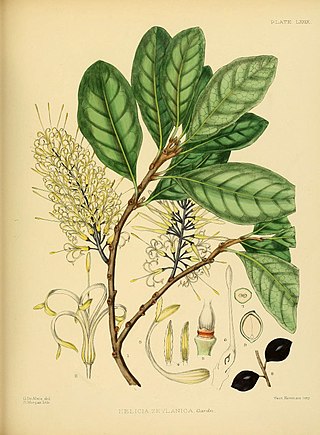
Triunia is a genus of medium to tall shrubs or small trees found as understorey plants in rainforests of eastern Australia. Members of the plant family Proteaceae, they are notable for their poisonous fleshy fruits or drupes. Only one species, T. youngiana, is commonly seen in cultivation.

Chionanthus, common name: fringetrees, is a genus of about 140 species of flowering plants in the family Oleaceae.

Helicia is a genus of 110 species of trees and shrubs, constituting part of the plant family Proteaceae. They grow naturally in rainforests throughout tropical South and Southeast Asia, including India, Sri Lanka, Indochina, Peninsular Malaysia to New Guinea and as far south as New South Wales.
Heliciopsis montana is a species of plant in the family Proteaceae. It is a tree endemic to Peninsular Malaysia. It is threatened by habitat loss. The Latin specific epithet montana refers to mountains or coming from mountains.
Heliciopsis rufidula is a species of plant in the family Proteaceae. It is a tree found in Peninsular Malaysia and Borneo. It is threatened by habitat loss.
Helicia attenuata is a plant in the family Proteaceae. The specific epithet attenuata means 'drawn out', referring to the leaf base.
Helicia excelsa is a plant in the family Proteaceae. It grows as a tree up to 20 metres (70 ft) tall, with a trunk diameter of up to 25 centimetres (10 in). The bark is dark grey to blackish. Inflorescences bear up to three reddish brown flowers. Fruit is black, ellipsoid, up to 3 centimetres (1 in) long. The specific epithet excelsa is from the Latin meaning 'lofty', referring to the tree's growth. Habitat is forests from sea level to 1,700 metres (5,600 ft) altitude. H. excelsa is found in Bangladesh, Burma, Thailand, Malaysia and Indonesia.
Helicia fuscotomentosa is a plant in the family Proteaceae. It grows as a tree up to 25 metres (80 ft) tall, with a trunk diameter of up to 30 centimetres (12 in). The bark is mottled grey and black. The flowers are reddish brown. Its habitat is forests from sea level to 2,000 metres (6,600 ft) altitude. H. fuscotomentosa is endemic to Borneo.
Helicia maxwelliana is a plant in the family Proteaceae. It is named for D. R. Maxwell, who accompanied botanist Lilian Gibbs on her 1910 Mount Kinabalu expedition, where she recorded numerous new plant species.
Helicia petiolaris is a plant in the family Proteaceae. The specific epithet petiolaris means 'stalked', referring to the leaves.
Helicia pterygota is a plant in the family Proteaceae. The specific epithet pterygota means 'winged', referring to the pedicel.
Heliciopsis velutina is a species of trees, in the family Proteaceae. They grow up to 25 metres (80 ft) tall, with a trunk diameter of up to 25 cm (10 in). The bark is dark brown. They have reddish brown flowers. They have brown, ellipsoid fruits up to 4 cm (2 in) long. The specific epithet velutina comes from the Latin meaning 'velvety', referring to the petiole. They grow naturally in lowland mixed dipterocarp forests' habitats from sea level to 600 metres (2,000 ft) altitude in Peninsular Malaysia and Borneo.
Palaquium ottolanderi is a tree in the family Sapotaceae.

Chisocheton is a genus of trees in the family Meliaceae. The genus name comes from the Greek schizos and chiton meaning "split tunic", referring to the lobed staminal tube of C. patens. Their range is from India and tropical China, throughout Malesia and south to New South Wales and Vanuatu.
Helicia symplocoides is a tree in the family Proteaceae, native to Borneo. The specific epithet symplocoides refers to the leaves' resemblance to those of the genus Symplocos.
Helicia rufescens is a tree in the family Proteaceae, native to Southeast Asia. The specific epithet rufescens means 'becoming reddish', referring to the indumentum of the inflorescences, twigs and leaves.
Helicia sessilifolia is a tree in the family Proteaceae, native to Borneo. The specific epithet sessilifolia refers to the sessile leaves.
Heliciopsis litseifolia is a tree in the family Proteaceae, native to Southeast Asia. The specific epithet litseifolia refers to the similarity of the leaves to those of the genus Litsea.
Heliciopsis mahmudii is a tree in the family Proteaceae, native to Borneo. It is named for the former Chief Minister of Sarawak, Abdul Taib Mahmud.
Heliciopsis percoriacea is a tree in the family Proteaceae, native to Borneo. The specific epithet percoriacea means 'very leathery', referring to the leaves.



